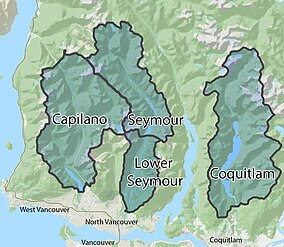The Metro Vancouver watersheds, also known as the Greater Vancouver watersheds, supply potable water to approximately 2.7 million residents in the Lower Mainland of British Columbia.[1] They provide tap water to a land area covering more than 2,600 square kilometres (1,000 sq mi), serving a total of 21 member municipalities, one electoral district, and one treaty First Nation.[2] From west to east, the watersheds are the Capilano (19,545 ha; 48,300 acres),[3] the Seymour (12,375 ha; 30,580 acres),[3] and the Coquitlam (20,461 ha; 50,560 acres).[3] They are located in the North Shore Mountains and Coquitlam Mountain, respectively. Each watershed possesses a reservoir for water storage purposes, under the control of Metro Vancouver. The reservoirs are supplied by about 3.5 metres (11 ft) of rain and 4.5 metres (15 ft) of snowpack annually.[4] Two additional off-catchment areas (Lower Seymour Conservation Reserve and Or Creek watershed) under control of Metro Vancouver contribute to the water supply.[3] The watersheds have a long history of controversies surrounding logging, highway development, and salmon run conservation.
- ^ Vancouver, Metro. "Sources & Supply". www.metrovancouver.org. Retrieved 2016-01-25.
- ^ Dunphy, Martin (2020-10-30). "Three workers fired in aftermath of Cleveland Dam incident that resulted in one dead, one missing". The Georgia Straight. Retrieved 2021-02-03.
- ^ a b c d http://www.bctwa.org/AboutGreaterVanWatersheds.pdf
- ^ "Our Drinking Water Source". Our Drinking Water Source. Metro Vancouver. Retrieved 3 April 2016.
